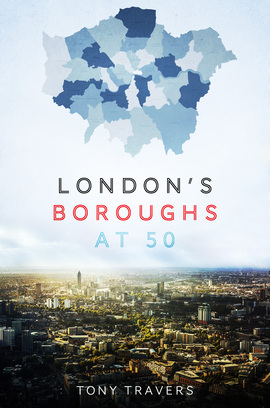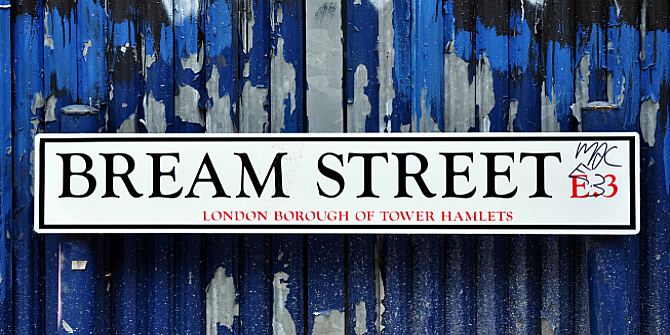Book Review: London’s Boroughs at 50 by Tony Travers
On 1 April 1965, a new system of city government was introduced to London, resulting in the birth of 32 boroughs. In London’s Boroughs at 50, Tony Travers traces the emergence and development of each of these individual and diverse boroughs that have played a key role in revolutionising the city and the lives of its inhabitants over the past fifty years. Jane Wills highly recommends this book, which raises important questions about the multi-scalar governance of London.
London’s Boroughs at 50. Tony Travers. Biteback Publishing. 2015.
 There is nothing more likely to turn people off politics than talk of local government. Our councils are credited with very little in the way of political virtue and tend to come into view only when things have gone wrong. Imagine trying to pitch a book that describes the work of 32 such councils over a 50-year period to a mainstream publisher and the snoring and snorting that might result.
There is nothing more likely to turn people off politics than talk of local government. Our councils are credited with very little in the way of political virtue and tend to come into view only when things have gone wrong. Imagine trying to pitch a book that describes the work of 32 such councils over a 50-year period to a mainstream publisher and the snoring and snorting that might result.
Despite the odds, however, London’s Boroughs at 50 has been published by a mainstream publisher. It is authored by London’s leading academic on London, Tony Travers, and it is highly recommended. The book takes us back to the 1963 Local Government Act and the legislation that led to the creation of 32 new London boroughs and the Greater London Council (GLC) on 1 April 1965. While the City of London retained the freedoms granted by William the Conqueror and the Magna Carta, the other boroughs we know today were created either by merging older and smaller jurisdictions or by carving out territory from the neighbouring shires of Essex, Kent, Middlesex and Surrey.
Travers tells the story of each of these boroughs while also providing an overview of the whole. He looks at the remarkable economic, demographic, social and political changes that have taken place over the last 50 years while also providing some insightful counterfactuals of what might have been. He asks: what if the GLC had not been abolished and had become a single council for the whole city? What if the reforms had created 51 boroughs as originally planned? So much for structures but so too for policy. What if housing policy, roads and development had been otherwise? These counterfactuals reveal much about why London’s government matters so much: the boroughs may be overlooked but they have shaped the city far more than our various leaders at the GLC or in London’s Mayorship.
As might be expected with a book like this, I focused on my own borough – Haringey – and it’s not a pretty story. I discovered that the Archway Road remains an eyesore due to plans for a road-widening scheme to link the M1 to the city centre that were contested from the earliest days of the borough’s existence. I then discovered that the Broadwater Farm Estate was built as late as the 1970s; it was in trouble almost as soon as it opened with major riots in 1985. The failings of local government and the police resurfaced in 2000 and 2007 following the deaths of Victoria Climbié and Baby Peter, and in 2011 when Mark Duggan was shot and killed. There have probably been more public inquiries about failings in Haringey than in any other place in the land. Reading about the story of your borough might make for happier reading.

Beyond the detail of particular boroughs, however, Travers also explores some overarching themes. He reminds us that London has developed, expanded and flourished despite the best-laid plans of the brave new planners that had long had designs on the capital. The British love for muddling through, making ad-hoc changes here and there and getting stuck in intractable arguments about what should be done have served the capital remarkably well. Despite the piecemeal incorporation of the political jurisdictions that developed during feudal times, London has become a successful world city. While London’s administrators have experimented and collaborated when they needed to – setting up a Metropolitan Board of Works to facilitate Joseph Bazalgette’s work on the sewers or the London Passenger Transport Board to support the bus and tram system, for example – there has been little appetite for drastic reform. Indeed, London’s system of government has been only rarely punctuated by major reform, such as the creation of the borough system and the London County Council in 1888 and 1889, and then via the 1963 Act that determined the cartography of government still practised today.
Travers argues that our historical inheritance has left us with a ‘bottom heavy, two tiered system’ that has served the city surprisingly well. While this makes change difficult, it has also helped to protect much that we love about the city today. In this regard, Travers approvingly cites Peter Rees, former City of London planning officer, who remarked: ‘The greatest thing about London is that it’s unplannable. The worst thing about it is that it’s unplanned’ (344). In contrast to cities like Berlin, Paris and New York, London has very weak metropolitan-wide government. Despite the best designs of its planners, London’s chaotic model of government has helped to protect the range of interests that need to be manifest in a city’s material culture.
It is important to remember that when the boroughs were created in the 1960s, London’s population had been in decline and everyone expected this to continue. No one predicted the growth that has taken place since the late 1990s; while the book documents the ever-present but always-changing crisis in housing that afflicts the city, the recent population boom has put unprecedented pressure on all urban infrastructure. History suggests that this crisis may prompt new ad-hoc measures for getting things done and this is likely to increase friction over the boundaries of political jurisdictions. While the boroughs remain the key gatekeepers to urban development, they need to strike good deals with developers to create the infrastructure we need. There is mixed evidence that they are up to this task. This makes them more vulnerable to outside interference, and the book rightly reminds us of the potential risks of grand London-wide schemes as were planned for our roads.
However, Travers also highlights the fact that central government decisions have generally proved more important than any London-based plans. Many of the key development decisions have depended upon the Treasury and national politicians more than London’s borough councillors or even the Mayor. This is true in relation to economic policy, such as the impact of the ‘Big Bang’ on the city in the 1980s as well as the immigration regime, but it is also true in relation to infrastructure development. ‘The creation of the London Docklands Development Corporation, the construction of the Docklands Light Railway, the extension of the Jubilee line, Crossrail and the decision to back the 2012 Olympic Games’ (297) all depended upon Treasury backing.
As such, London’s Boroughs at 50 raises important questions about the multi-scalar governance of the city. The book argues that, by serendipity as much as anything else, the boroughs have served the city well. Travers puts this down to the fact that they ‘were broadly the correct size to be both ‘‘local’’ and yet powerful’ (347). For him, ‘any smaller and they would have been under-powered; any larger and they might have been remote’ (349).
However, many would argue that London’s boroughs are too remote from the people. Rather unexpectedly, the nineteenth-century battles between Joshua Toulmin-Smith and zealous reformers over the importance of the urban parish have not disappeared. They resurfaced in Michael Young’s campaign for community councils in the 1970s, and they are now manifest in neighbourhood planning and the work of new parish-like structures like the one set up in Queen’s Park (see Baker and Young, The Hornsey Plan, 1971; and Wills, 2016). A borough like Haringey makes little sense to its residents who are more naturally focused on the centres that make up its parts: Crouch End, Highgate, Muswell Hill, Stroud Green, Tottenham and Wood Green. Although London’s boroughs may well remain for another 50 years, it is likely that another tier of civic organisation will develop at the scale of the parish or neighbourhood in the years ahead.
Travers is an insider who knows all the key players in his story. He understands that politics is about the art of the possible. This is a strength as well as a weakness. It makes it harder to challenge the existing order of things. Indeed, in places he rather understates the madness of local politics during the 1980s when councils were worrying about nuclear disarmament rather than the state of their own housing stock. There is scope for bringing a more critical eye to the state of local government; in this regard there has been a long-running argument about the need for our administrative boundaries and political representatives to better match our everyday geographies of the city. These arguments will never go away and whatever happens, Tony Travers will have something interesting to say about it. I warmly recommend this book.
—
Note: This review gives the views of the author, and not the position of the Democratic Audit blog, or of the London School of Economics. It originally appeared on the LSE Review of Books. Please read our comments policy before posting. Image credit: Bream Street, London Borough of Tower Hamlets (George Rex CC2.0)
—
Jane Wills is Professor of Human Geography at Queen Mary, University of London.





 Democratic Audit's core funding is provided by the Joseph Rowntree Charitable Trust. Additional funding is provided by the London School of Economics.
Democratic Audit's core funding is provided by the Joseph Rowntree Charitable Trust. Additional funding is provided by the London School of Economics.
Book Review: London’s Boroughs at 50 by Tony Travers https://t.co/VmF29XKTV6
TOWER HAMLETS: Book Review: London’s Boroughs at 50 by Tony Travers – Democratic Audit UK https://t.co/AJfPtp9ygo #London
Book Review: London’s Boroughs at 50 by Tony Travers https://t.co/6bI7TLxd6w https://t.co/Os3LFDSb5O